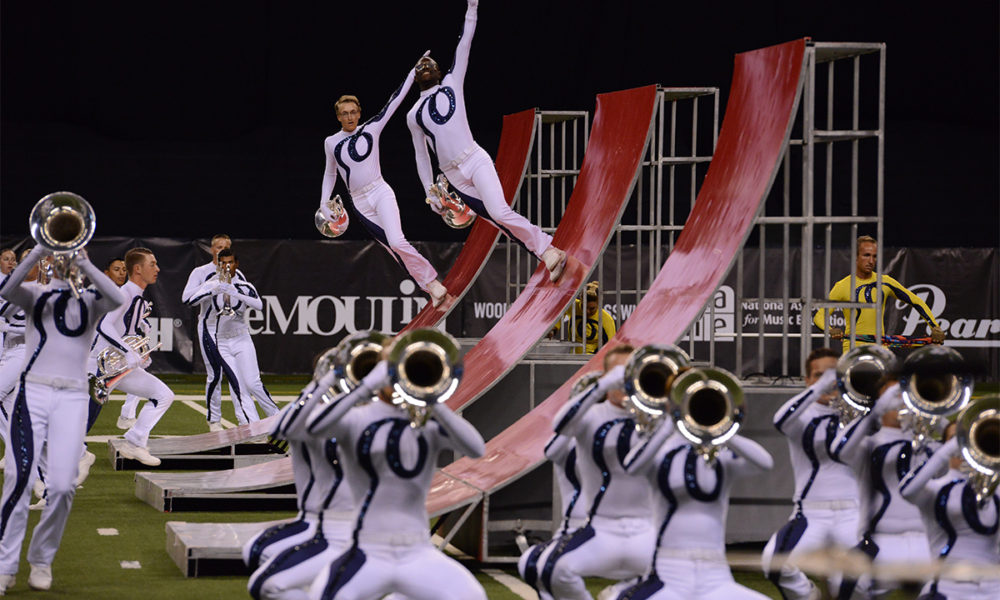A new champion in a strange uniform. New finalists wowing audiences. Bigger sets and bigger props. It was history in the making at Drum Corps International’s 2016 championships.
 For Drum Corps International, 2016 was a year of surprises. The Bluecoats took home its first World Class championship while Legends placed third in Open Class competition for the first time ever. At the end of the night, the top three groups in World Class had less than one point separating their final scores.
For Drum Corps International, 2016 was a year of surprises. The Bluecoats took home its first World Class championship while Legends placed third in Open Class competition for the first time ever. At the end of the night, the top three groups in World Class had less than one point separating their final scores.
Bluecoats Turn DCI Down Side Up
For the Bluecoats of Canton, Ohio, the 2016 season was a time for innovation. “We tried to push the boundaries,” says executive director David Glasgow.
This risk paid off for the Bluecoats, which finished its season with a score of 97.650, earning the corps its first-ever gold medal.
The Bluecoats’ show, titled “Down Side Up,” focused less on trying to tell a story and more on directly communicating with the audience. “We wanted to assault the senses through sound [and] sight and also in terms of how we used props,” Glasgow says.
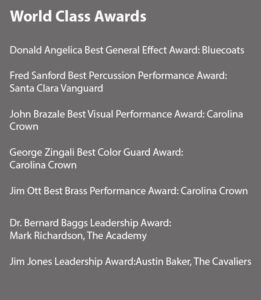 By a Landslide?
By a Landslide?
The show featured interaction between corps members and 10-foot slides set around the field. Four of these slides were stationary with elevators attached to the back. Soloists would use these elevators to reach the top of the slide in time for their big moment. Six additional slides were mobile. Corps members would go up and down the slides as they performed.
“‘Down Side Up’ [means] we’re sliding down slides, but I think it transformed into something bigger,” says drum major Samuel Crawford. “The theme was turning the activity of drum corps down side up.”
Uniform Makeover
Efforts to turn DCI down side up extended beyond the Bluecoats’ unconventional show. This year, the Bluecoats unveiled a set of brand-new uniforms. Historically, the corps has donned a police-inspired blue coat since the group originated as a tribute to the Canton Police Boys Club. This year, however, the corps opted for something completely different.
Its stretchy, fitted, white-and-blue uniforms, worn without any type of hat, were something never before seen in drum corps.
“Down Side Up” required musicians and color guard to incorporate dance choreography in addition to drill into their movement. Therefore, a uniform change became somewhat of a necessity. “It was practicality of movement,” Glasgow says.
At first, such a drastic change in uniform made some members apprehensive. “They really leave nothing to the imagination,” Crawford says.
However, during the first week of spring training, all corps members were ready to take a chance on the new uniforms. “We were thankful that Dave [Glasgow] made that very gutsy call to take the hats off,” Crawford says.
Though performing without hats seemed unusual to many members at first, they embraced the way it allowed them to connect with the audience. “Being able to engage the audience with our eyes became the most enjoyable part of the experience,” Crawford says. “It’s really intimate and powerful.”
Glasgow says that tailoring the uniform to the show paid off well for the Bluecoats. “It’s something we’re going to continue to explore,” he says. “No one should expect us to look exactly the same.”
Counting Blessings
Winning first place in World Class as well as the Donald Angelica Best General Effect Award was a hard-fought battle. Due to lack of funding, the Bluecoats have had to fold twice—in 1979 and 1983—since its beginning in 1972. “Every time we came back a little stronger,” Glasgow says. “To be able to develop to where we are today is incredibly exciting.”
And, of course, corps members were thrilled with this year’s historic moment. “It was awesome to win,” Crawford says. “The moment we stepped off the field [after] our performance, we hugged each other, and people started crying. It was one of those moments when I couldn’t stop smiling.”
 A Silver Streak for The Blue Devils
A Silver Streak for The Blue Devils
With a score of 97.250, The Blue Devils of Concord, California, trailed behind the Bluecoats by four tenths of a point, ultimately earning a silver medal. With this year’s finish, The Blue Devils continued its decade-long tradition of finishing in the top two corps at DCI Championships. “We’ve won six out of the last 10 [and received] four second places,” says The Blue Devils executive director David Gibbs. “We haven’t been out of the top four since 1975.”
Behind The Blue Devils’ success this year was a show called “As Dreams Are Made On,” which surpassed a normal DCI performance and became an all-out theatrical experience. “It was theater on 100 yards,” says corps director Patrick Seidling.
Sounds and Sweet Airs
Based on the play “The Tempest,” The Blue Devils’ show honored William Shakespeare in the 400th year since his death. “As Dreams Are Made On” opened with a large blue piece of fabric draped across the field, signifying the ocean. The opening drill featured corps members moving in the shape of a tidal wave, representing the shipwreck that served as the show’s inciting incident. This fast-paced introduction captured the audience’s attention.
“Right away we kicked the show off with this tidal wave, then off we go with the fantasy story of ‘The Tempest,’” Seidling says.
Traveling Theater
The Blue Devils incorporated many theatrical elements into its marching show, which sometimes made touring a challenge. For props, The Blue Devils displayed 14 scaffolding sets across the field as well as the oceanic blue fabric. Additionally, the color guard had many costume changes into Shakespearean and nautical-style clothing. “We had a pretty big production to move from town to town,” Seidling says.
To accommodate travel, the corps used an additional semi-truck to move the stage set and traveled with roadies, whose job was assembling and deconstructing the set at each performance. “It was one step beyond a drum and bugle corps and became a traveling theater company,” Seidling says.
The extra work to perform such a complex show paid off in the pride the corps felt after its final performance. “The members actually did master all the elements of a complex show,” Seidling says. “Our performance was as good as any we’ve had in decades.”
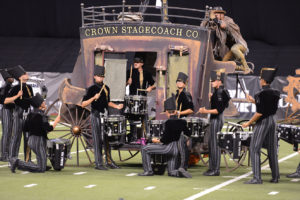 Carolina Crown: Bronze and Beyond
Carolina Crown: Bronze and Beyond
Taking home a bronze medal was not all that Carolina Crown, based in Fort Mill, South Carolina, had to celebrate. Along with a score of 97.088, the corps won three caption awards: the John Brazale Best Visual Performance Award, the George Zingali Best Color Guard Award, and the Jim Ott Best Brass Performance Award.
“We were ecstatic with our bronze medal and even more honored to win the awards,” says drum major Emily Salgado.
Steampunk Spaghetti Western
Crown’s 2016 show, titled “Relentless,” explored the theme of revenge through a genre called, in executive director Jim Coates’s words, “steampunk spaghetti western.”
“Relentless” took the audience on an emotional journey, following a young man as he searched for his father’s murderer in pursuit of revenge.
The show’s set included a prop stagecoach, which was inspired by the 2012 film “Django Unchained” and moved across the field as the story progressed. At one point in the show, the stagecoach stopped in a saloon town, and the corps acted out a barroom brawl scene. As the musicians played “El Tango de Roxanne,” color guard members danced with bar stools.
A Deeper Message
The closing scene to “Relentless” as well as its ultimate message changed as the season progressed. “The closer originally ended with the [murderer’s] death,” Salgado says.
By the end of the season, however, Crown opted for a different finish. Instead of being killed, the murderer was shuttled off to jail in the stagecoach. “We ended it with not killing the person but throwing the guns down,” Coates says.
This change in story allowed the show to convey a different and ultimately deeper message. “What started as a show of ultimate revenge ended with a message of mercy and forgiveness,” Salgado says.
Coates adds: “You can take pursuit of vengeance in a relentless way, and still have mercy at the end.”
After giving a memorable final performance at championships and taking home a bronze medal, Crown members were proud of their successful season. They were thankful for the tough competition that motivated them to keep getting stronger.
“The Blue Devils gave us good competition all season long as well as the Bluecoats,” Coates says. “We’re happy for [Bluecoats] to win their first championship. When the scores were announced, the three corps were appreciative of each other. It was all about going through the season and being tight competitors.”
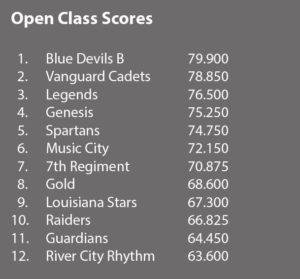 Competition in Open Class
Competition in Open Class
The competition in Open Class saw old favorites and a relatively new contender in the top three.
Blue Devils B Soars Above
In the Open Class, Blue Devils B took audiences on an out-of-this-world adventure with its show “To the Moon.” Earning a final score of 79.900, Blue Devils B won first place in Open Class as well as 15th place overall.
“To the Moon” portrayed the space race between Russia and the United States, ultimately ending with the 1969 moon landing. To engage audiences in the show, Blue Devils B used a variety of visual and auditory components. During the space race scenes, corps members stood on two halves of the field—one side representing Russia, the other America. Additionally, the show featured drill formations of stars, galaxies, and the moon. The show featured music from “Apollo 13.”
To create a more immersive experience, the corps played some historical sound bites throughout the show. At the end of the show, the corps re-enacted the 1969 moon landing, complete with Neil Armstrong adorning the moon with an American flag. “The show ended up being very patriotic,” says Rick Odello, director of Blue Devils B.
In the background, the audience could hear a recording of Armstrong’s famous quote: “That’s one small step for man, one giant leap for mankind.” “[It] was a very emotional finish,” Odello says.
In addition to taking home the gold medal, Blue Devils B won all of the caption awards in Open Class. “The performers were absolutely ecstatic,” says staff coordinator and percussion caption head Ryan Odello. “What set this year apart is that they fully trusted the staff and the program we gave them and really brought it to life with the performance.”
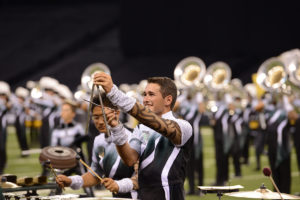 The One and Only Vanguard Cadets
The One and Only Vanguard Cadets
Taking second place in Open Class, with a score of 78.850, were the Vanguard Cadets out of Santa Clara, California. Originating in the 1970s as the B corps to the Santa Clara Vanguard, the corps has won either a gold, silver, or bronze medal every year since 2008.
The Vanguard Cadets’ 2016 show, titled “The One,” explored what it means to be a hero. Featuring one girl as the main character—the hero—the show drew a lot of inspiration from the popular book and movie series “The Hunger Games.” “We all could be the one person to make a difference,” says corps director Steve Barnhill.
Overall, “The One” was about overcoming and rising above one’s personal struggles. To represent the concept of individualism, “The One” featured a lot of solo musicians, including a percussion solo that represented a fight. “We highlighted different struggles you go through in life and ultimately thriving beyond,” Barnhill says.
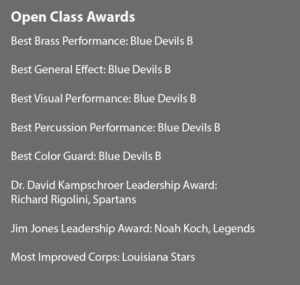 In addition to earning the silver medal for the Open Class, the Vanguard Cadets placed 20th overall. “I was very proud of them,” Barnhill says. “It was bittersweet; we want to win, and we have a membership good enough to win. We definitely gave our best effort. That finals night in Michigan City, they were stellar.”
In addition to earning the silver medal for the Open Class, the Vanguard Cadets placed 20th overall. “I was very proud of them,” Barnhill says. “It was bittersweet; we want to win, and we have a membership good enough to win. We definitely gave our best effort. That finals night in Michigan City, they were stellar.”
Now that DCI championships are over, the Vanguard Cadets are excitedly looking forward to next year. “We’ve jumped on some design ideas to set ourselves up for next year while it’s still fresh,” Barnhill says.
This upcoming season has a special meaning to the corps: 2017 marks Santa Clara Vanguard’s 50th anniversary. To celebrate, both corps will start off the year marching together in the Tournament of Roses Parade. “Celebrating 50 years of excellence … it’s going to be a busy year for us,” says Barnhill.
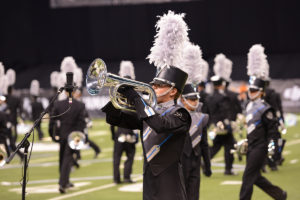 Legends and Infectious
Legends and Infectious
With a score of 76.500, this year’s Open Class bronze medalist was somewhat of a newcomer to DCI. Legends, a corps based out of Kalamazoo, Michigan, has existed only since 2006. However, Legends has been quickly establishing itself in the DCI scene, having won Most Improved Corps three times since its founding.
Legends’ 2016 show, “The Grid,” represented a futuristic view of electronics. Featuring music from “Tron: Legacy” and “The Matrix Reloaded,” the program told an abstract science fiction story about technology. Corps members represented a grid through their use of angular and square drill formations. “We wanted to keep the theme abstract,” says Ibe Sodawalla, Legends founder and director.
In one movement of the show, Legends portrayed an Internet virus taking over. “The guard costuming was dark, cloak-like,” says Sodawalla. “[It] looked like Neo from ‘The Matrix.’”
Then guard members removed their cloaks to reveal bright green costumes underneath. “That was the virus inside of the grid,” Sodawalla says.
To visually show the virus spreading, corps members had LED lights attached to their shakos. In each show, more members would be affected by the virus. By the time the corps reached championships, even the podium and drum major uniform featured the LED lights. Over the course of the season, parents, fans, and other audience members started bringing glow sticks to Legends’ shows, creating the effect of the audience being infected by the virus as well.
This year marked Legends’ first medal at DCI championships. “I was so proud of the group and all the obstacles we had to overcome,” says drum major Noah Koch.
Koch has been a member of Legends since 2008, first as an auxiliary percussionist, then as a tuba player, and finally as a drum major starting in 2014. This year, Koch won the Jim Jones Leadership Award for Open Class. “I’m still kind of processing the whole deal,” Koch says. “The members push me to be a better leader every day.”

